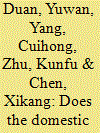|
|
|
Sort Order |
|
|
|
Items / Page
|
|
|
|
|
|
|
| Srl | Item |
| 1 |
ID:
114793


|
|
|
|
|
| Publication |
2012.
|
| Summary/Abstract |
Since 2001, the exports of foreign-invested enterprises (FIEs) have accounted for more than 50 percent of China's total exports. As foreign capital occupies a high proportion of the total capital of FIEs, most FIEs' capital gains are foreign factor income. Although these gains are calculated as a part of China's GDP, they do not belong to China's national income. To determine the real contribution of exports to China's welfare, the present paper analyses the impact of exports on China's national income using a non-competitive input-output model capturing processing trade. The results show that every US$1000 of China's exports generates US$506.8 of national income. The real contribution of exports to China's welfare is much smaller than what we expected. This suggests that China should endeavor to improve the gains from international markets or find another engine to maintain its economic growth.
|
|
|
|
|
|
|
|
|
|
|
|
|
|
|
|
| 2 |
ID:
116509


|
|
|
|
|
| Publication |
2012.
|
| Summary/Abstract |
We develop an input-output methodology to estimate how Chinese exports affected the country's total domestic value added (DVA) and employment in the years 2002 and 2007. For every US$1000 dollar of Chinese exports in 2007 (2002), DVA and employment are estimated to be US$591 (US$466) and 0.096 (0.242) person-year, respectively. To implement these estimations, we use hitherto unpublished Chinese government data to construct several completely new datasets, including an input-output table with separate input-output and employment-output coefficients for processing exports, non-processing exports, and output for domestic use. We hypothesize that, in comparison with the export sector, China's domestic sector would be relatively autarkic due to China's history of central planning. We expect that exports would generate less DVA and employment than output for domestic use. Processing exports, which are highly dependent on imported inputs, would similarly generate less DVA and employment than non-processing exports. Our findings support these expectations. For both 2002 and 2007, the DVA and employment effects of domestic final demand were higher than those of non-processing exports, which were in turn higher than those of processing exports. However, with the progress of economic reforms, we found that the total DVAs of exports and domestic final demand have converged from 2002 to 2007.
|
|
|
|
|
|
|
|
|
|
|
|
|
|
|
|
|
|
|
|
|